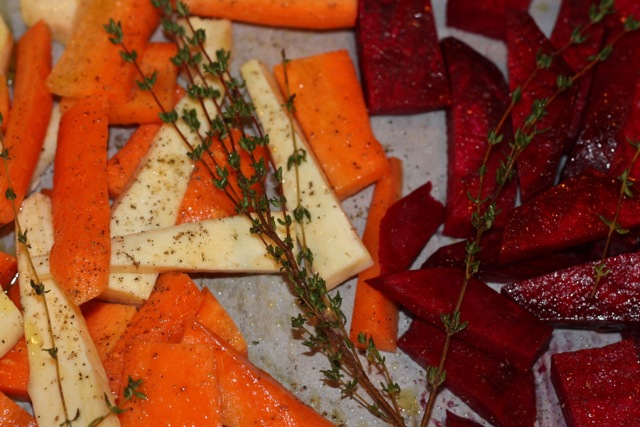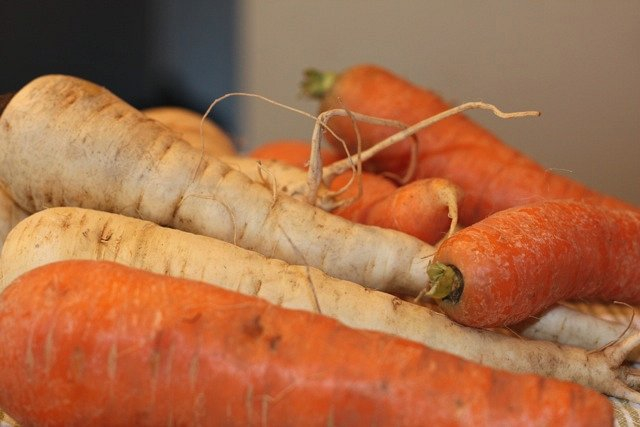Being part of a CSA (community supported agriculture-farm share program), I have many roots (veggies) in my life.
As the cold weather approaches, warm soups and hearty stews once again make their winter debut. Why not add a mix of flavorful root vegetables to your favorite recipe?
After months of retrieving nutrients from the soil, many root vegetables are ready for harvest in late fall. Our ancestors relied heavily on the nourishment provided by these roots to sustain them through out the harsh New England winters. With the advent of proper refridgeration, and food distribution methods, these unusual (you could even say, ‘ugly’) looking roots, now, often get overlooked.
Look what I made with my root veggies this week! MMMM 🙂
Stick true to your roots. What is a true root vegetable, anyway?
Root vegetables are plant roots that are enjoyed as vegetables. Although most people refer to all vegetables grown under grown as root vegetables, in order to be a true root the plant must be tuberous root and taproot.
Carrots, rutabagas, turnips, parsnips, beets and sweet potatoes are some of the true root vegetables. Although yams and sweet potatoes are often considered one in the same, yams are tubers and are not consider a true root. For a kick of Vitamin C, A, B and fiber, consider adding these fruits of the earth to your weekly grocery list. {FODMAPers carrots, parsnips, turnips and rutabaga are low in FODMAPs while sweet potato and beets have moderate amounts and should be enjoyed in small quantity!}
Did you know that ancient Greek civilizations thought carrots were “love medicine” and were often used as an aphrodisiac? Hmmmm…..
Roots 101
- Turnips-this round root with the purple top is terrific when boiled and mashed like potatoes. The flesh of a turnip can be white or yellow. Peel the turnip before cooking. It can also be chopped and added to any stew or soup. Do not cook turnips in an aluminum or iron pot as the anthoxanthins, plant chemicals in their skin interact and leave the turnip looking an unappealing grey. A half-cup of cooked turnips offers 2 grams of fiber, a nice dose of Vitamin C and a measly 15 Calories.
- Rutabaga—This big guy looks like an over grown turnip but they are actually very different vegetables. Harvested in late fall, the cold temperatures help this vegetable develop a rich flavor. Chopped up this makes a nice addition to any soup or stew vegetable. Just 35 Calories and 2 grams of fiber all in just a half cup cooked rutabaga.
- Parsnip-This long white lanky root, looks like a white carrot. Try roasting this vegetable or add to any soup or stew recipe. Peak harvest for this vegetable is from fall to spring. “To me, a true sign of spring is parsnips, sliced thinly and sautéed in a little butter over a low flame until they’re tender” –Edward C. Smith, author of The Vegetable Gardener’s Bible. Parsnips offer a great source of vitamin C, a whopping three grams of fiber and 60 Calories in just a half cup cooked serving.
- Beets- this root comes in a variety of colors such as gold, red and striped. Beets are sweet but low in calories. Try fresh, roasted or canned beets on top of your favorite salad or as side dish. My personal favorite is roasted beets; the natural sugar in beets with a little olive oil, sea salt and pepper brings about a wonderful taste. Cooked, per half cup, beets provide 2 grams of fiber and only 35 calories.
- Sweet potato-this root is a favorite in the southern American States. They are yellow or orange and typically have pointy ends. Sweet potatoes are rich in Vitamin A. They taste fantastic when served as baked French Fries, but also a quite nice mashed, in breads, pies and soups. Sweet potatoes have 50 Calories, 1-gram fiber, a great source for potassium and Vitamin A.
And for those who thought this post was about discovering your family history and actually want to learn more about your heritage and relatives, check out this site.
Here are my diced up roots ready to hit the oven for some roasting…
To make my roasted roots, I always like to add a bit of fresh thyme. Thyme infuses a nice flavor to the roots without overwhelming their naturally yummy taste.
-
Ingredients
- 3 carrots, peeled and sliced in half, and cut into 6 chunks
- 3 parsnips, prepared as above
- 1 large beet-washed, peeled and cut in 1 ½ inch chunks
- 1 large sweet potato, scrubbed, and cut in 1 1/2 inch chunks
- 1-2 Tablespoons Olive oil
- Sea salt
- Pepper
- Optional: 1-2 T. fresh chopped thyme or 2 branches
Instructions
- Preheat oven to 375 degrees.
- On large cookie sheet place all cut roots. Drizzle with olive oil-and use a brush to evenly distribute the oil.
- Add a dash of salt and a lavish dash of pepper to all vegetables.
- Top roots with fresh thyme branch or fresh leaves.
- Roast in oven for about 30 minutes until all vegetables are fork tender and caramelized. Flip roots about every 10 minutes to cook evenly.
- FODMAPers Limit beet to 4 slices or 1/2 cup sweet potato and enjoy the roasted carrots and parsnip or sub in rutabaga and turnip for the beets/sweet potato to enjoy more freely.






Dixya @ Food, Pleasure and Health
i love root vegetables roasted and blend them into soups. great info on these veggies 🙂